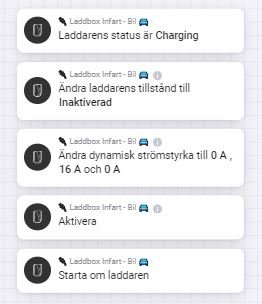152 271 läst · 1 557 svar
152k läst
1,6k svar
Zaptec eller Easee som andra laddbox?
Självbyggare
· Stockholm
· 9 897 inlägg
Jag vet inget särskilt om Pulse, men så måste det väl vara. Easee kör bara med 4G by default. Sen kan man utöver det ansluta den till Wi-Fi, men det är inget man kan ta för givet. Och någon annan sorts kommunikation finns inte, såvitt jag vet.Nissens skrev:
Jo, även Easeelink som är nå radiovågor. https://support.easee.com/hc/en-gb/...5-How-far-does-the-EaseeLink-radio-signal-go-T tomasfr skrev:
Diskuterades för några dagar sedan. Med Tibbers smartladdning och lastbalansering kommer den inte att fungera alls. Equalizern fungerar ändå. Det går att dra igång laddning även när boxen är offline, och om man vill ha styrning utifrån elpris får man styra laddningen från bilen.T tomasfr skrev:
Tveksamt dock om det går att ändra inställt schema i boxen om molnet försvinner.R rindler skrev:
Boxen vet nog inget om schemat utan hämtar infon från molnet, som jag förstår det. Så här skriver de själva. https://support.easee.com/hc/en-gb/articles/7925027240721-How-do-I-charge-my-car-offline-Nissens skrev:
Vet inte vad det är för app, men kan du minska begränsningen på enbart en fas där?lilytwig skrev:
Det går visst via Home assistant också. Men det är via molnet. Oklart dock varför Tibber inte klarar att göra det.
Redigerat:
Homeyappen kommunicerar via Easees moln. Det finns inget lokalt API, tyvärr. https://community.homey.app/t/app-pro-easee-charger/31647lilytwig skrev:
Hej Mikael_L
Du skrev i inlägg #1428"Jag är säker på att det ÖKAR säkerheten."
Jag skulle inte uttala mig tvärsäkert på det sättet. Du kan t.ex. läsa om ”Safe operating area” i Wikipedia ” For power semiconductor devices (such as BJT, MOSFET, thyristor or IGBT)” https://en.wikipedia.org/wiki/Safe_operating_area
I texten står bland annat; “Secondary breakdown is a failure mode in bipolar power transistors. In a power transistor with a large junction area, under certain conditions of current and voltage, the current concentrates in a small spot of the base-emitter junction. This causes local heating, progressing into a short between collector and emitter. This often leads to the destruction of the transistor.”
När man t.ex. bygger UPS eller en inverter baserad på kraftelektronik (”power semiconductor devices”) är det en problematik att kunna leverera höga startströmmar och att kunna lösa ut säkringar.
Lösningen brukar vara att man styr ned kraftelektroniken, för att begränsa strömmen.
Under rubriken “Protection” I texten jag länkade till står; ”The most common form of SOA protection used with bipolar junction transistors senses the collector-emitter current with a low-value series resistor. The voltage across this resistor is applied to a small auxiliary transistor that progressively 'steals' base current from the power device as it passes excess collector current. Another style of protection is to measure the temperature of the outside of the transistor, as an estimate of junction temperature, and reduce drive to the device or switch it off if the temperature is too high. If multiple transistors are used in parallel, only a few need to be monitored for case temperature to protect all parallel devices. This approach is effective but not bullet-proof. In practice, it is very difficult to design a protection circuit that will work under all conditions, and it is left up to the design engineer to weigh the likely fault conditions against the complexity and cost of the protection.”
Du får gärna påstå att det ökar säkerheten.
Jag håller det för tveksamt.
Kan du visa det du påstår, så varsågod.
Du skrev i inlägg #1428"Jag är säker på att det ÖKAR säkerheten."
Jag skulle inte uttala mig tvärsäkert på det sättet. Du kan t.ex. läsa om ”Safe operating area” i Wikipedia ” For power semiconductor devices (such as BJT, MOSFET, thyristor or IGBT)” https://en.wikipedia.org/wiki/Safe_operating_area
I texten står bland annat; “Secondary breakdown is a failure mode in bipolar power transistors. In a power transistor with a large junction area, under certain conditions of current and voltage, the current concentrates in a small spot of the base-emitter junction. This causes local heating, progressing into a short between collector and emitter. This often leads to the destruction of the transistor.”
När man t.ex. bygger UPS eller en inverter baserad på kraftelektronik (”power semiconductor devices”) är det en problematik att kunna leverera höga startströmmar och att kunna lösa ut säkringar.
Lösningen brukar vara att man styr ned kraftelektroniken, för att begränsa strömmen.
Under rubriken “Protection” I texten jag länkade till står; ”The most common form of SOA protection used with bipolar junction transistors senses the collector-emitter current with a low-value series resistor. The voltage across this resistor is applied to a small auxiliary transistor that progressively 'steals' base current from the power device as it passes excess collector current. Another style of protection is to measure the temperature of the outside of the transistor, as an estimate of junction temperature, and reduce drive to the device or switch it off if the temperature is too high. If multiple transistors are used in parallel, only a few need to be monitored for case temperature to protect all parallel devices. This approach is effective but not bullet-proof. In practice, it is very difficult to design a protection circuit that will work under all conditions, and it is left up to the design engineer to weigh the likely fault conditions against the complexity and cost of the protection.”
Du får gärna påstå att det ökar säkerheten.
Jag håller det för tveksamt.
Kan du visa det du påstår, så varsågod.
Redigerat:


